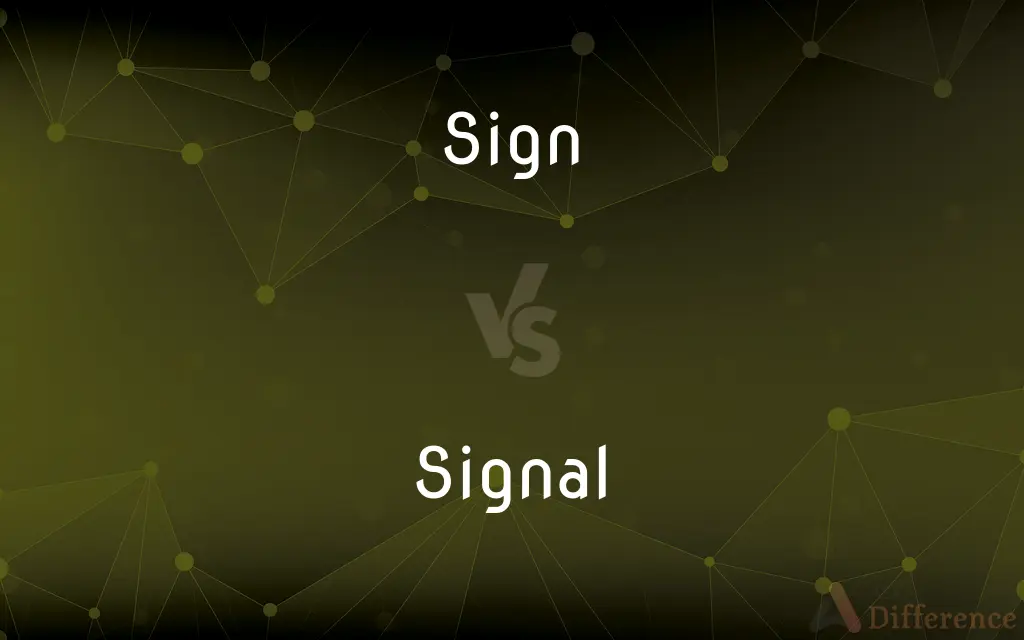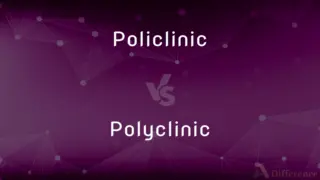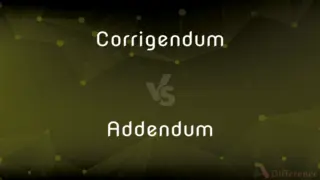Sign vs. Signal — What's the Difference?
By Fiza Rafique & Urooj Arif — Updated on February 25, 2024
A sign is a symbol or object used to convey information or instructions, while a signal is a gesture, action, or sound that communicates a message or triggers a response.

Difference Between Sign and Signal
Table of Contents
ADVERTISEMENT
Key Differences
Signs and signals both serve as means of communication, but they differ in form and function. A sign is typically static, like a road sign or a symbol. Signals, however, are dynamic and can be visual, auditory, or physical. They convey messages through changes, movements, or sounds.
Sign providing guidance, warnings, or information without changing. It's a physical or visual representation meant to be interpreted. Signal like, a traffic light changing color is a signal, as is a whistle blown by a referee. Signals often imply action or a change in state, triggering responses or indicating specific conditions.
The distinction between a sign and a signal lies in their application and interpretation. Signs are interpreted based on agreed-upon meanings or cultural understanding, like the "stop" sign. Signals require a receiver's awareness of the context and are often part of a system of communication, needing prior knowledge or instinct to understand, such as hand signals used by divers.
Both signs and signals are crucial in everyday life, guiding behavior, ensuring safety, and facilitating communication. However, their effectiveness depends on the clarity of their presentation and the understanding of their intended audience. Whether a sign or a signal, the goal is to convey a message clearly and efficiently.
Comparison Chart
Nature
Static
Dynamic
ADVERTISEMENT
Form
Symbols, objects
Gestures, actions, sounds
Function
Provide information or instructions
Communicate a message or trigger a response
Examples
Road signs, warning labels
Traffic lights, alarm sounds
Interpretation
Based on cultural or agreed-upon meanings
Requires context and awareness of communication systems
Communication Type
Direct and constant
Variable and responsive
Application
Navigation, safety, information dissemination
Communication, signaling systems, response initiation
Compare with Definitions
Sign
Symbol conveying information.
The exit sign guided us out of the building.
Signal
Communication through systematized actions.
Smoke signals were used for long-distance communication.
Sign
Indicator of a condition or presence.
Dark clouds are a sign of an approaching storm.
Signal
Sound conveying a warning or instruction.
The whistle is a signal for the end of the game.
Sign
A posted notice bearing a designation, direction, or command
An EXIT sign above a door.
A traffic sign.
Signal
Change indicating a specific condition.
A green light is a signal to go.
Sign
A trace or vestige
No sign of life.
Signal
To make a signal to
I signaled the driver to proceed.
Sign
(transitive) To communicate using gestures to (someone).
He signed me that I should follow him through the doorway.
Signal
Of or pertaining to signals, or the use of signals in conveying information; as, a signal flag or officer.
Sign
A perceptible indication of something not immediately apparent (as a visible clue that something has happened);
He showed signs of strain
They welcomed the signs of spring
Signal
Action triggering a response.
The fire alarm signal prompted an evacuation.
Sign
Object representing a rule or instruction.
A no smoking sign was posted at the entrance.
Signal
The sound, image, or message transmitted or received by means of telecommunications.
Sign
Visual or written communication.
The sign on the door said 'Closed for Maintenance'.
Signal
Gesture indicating a message.
He gave a signal to proceed.
Sign
Physical manifestation.
Fever is a sign of many infections.
Signal
In signal processing, a signal is a function that conveys information about a phenomenon. In electronics and telecommunications, it refers to any time varying voltage, current, or electromagnetic wave that carries information.
Sign
A gesture or action used to convey information or an instruction
She gave him the thumbs-up sign
Signal
To relate or make known by signals
They have signaled their willingness to negotiate.
Sign
A notice on public display that gives information or instructions in a written or symbolic form
I didn't see the ‘Stop’ sign
Signal
To make a signal or signals.
Sign
To make a sign or signs; signal.
Signal
(ambitransitive) To indicate; to convey or communicate by a signal.
I signalled my acquiescence with a nod.
He whistled to signal that we should stop.
Sign
To indicate
Signal
To communicate by signals; as, to signal orders.
Sign
To make a sign or signal; to communicate directions or intelligence by signs.
Signal
To notify by a signals; to make a signal or signals to; as, to signal a fleet to anchor.
Sign
A public display of a (usually written) message;
He posted signs in all the shop windows
Signal
Any communication that encodes a message;
Signals from the boat suddenly stopped
Sign
Structure displaying a board on which advertisements can be posted;
The highway was lined with signboards
Signal
Communicate silently and non-verbally by signals or signs;
He signed his disapproval with a dismissive hand gesture
The diner signaled the waiters to bring the menu
Sign
Having an indicated pole (as the distinction between positive and negative electric charges);
He got the polarity of the battery reversed
Charges of opposite sign
Sign
A character indicating a relation between quantities;
Don't forget the minus sign
Sign
Place signs, as along a road;
Sign an intersection
This road has been signed
Sign
Communicate in sign language;
I don't know how to sign, so I could not communicate with my deaf cousin
Common Curiosities
Are signals always intentional?
Signals are usually intentional, especially in human-made systems, but they can also occur naturally, like lightning signaling a storm.
What is the main difference between a sign and a signal?
The main difference lies in their nature; signs are static symbols providing information, while signals are dynamic indicators prompting action or conveying messages.
How do signs and signals facilitate communication?
They facilitate communication by providing clear, often universally understood messages to guide behavior, ensure safety, and trigger responses.
What role do signs and signals play in safety?
They are essential for safety, providing warnings, instructions, and information to prevent accidents and ensure orderly conduct in various settings.
How are signs and signals used in non-verbal communication?
In non-verbal communication, body language, facial expressions, and gestures serve as signals conveying emotions, intentions, and messages without words.
Can a signal be a sign?
While they serve different purposes, in some contexts, signals can function as signs, especially if they are used to convey a constant message.
Why is the interpretation of signs and signals important?
Correct interpretation ensures the intended message is received and acted upon accurately, which is crucial for safety, navigation, and effective communication.
Can technology change the way signs and signals are used?
Yes, technology can introduce new forms of signs and signals (like digital displays and electronic alerts) and change their usage patterns, making communication more efficient but also potentially more complex.
What challenges arise in the design of effective signs and signals?
Challenges include ensuring clarity, overcoming language and cultural barriers, and adapting to environmental conditions and technological changes to maintain effectiveness and comprehension.
How do cultural differences affect the understanding of signs and signals?
Cultural differences can significantly affect interpretation, as symbols and gestures might have different meanings across cultures, requiring localization of signs and adaptation of signals for universal understanding.
Share Your Discovery

Previous Comparison
Policlinic vs. Polyclinic
Next Comparison
Corrigendum vs. AddendumAuthor Spotlight
Written by
Fiza RafiqueFiza Rafique is a skilled content writer at AskDifference.com, where she meticulously refines and enhances written pieces. Drawing from her vast editorial expertise, Fiza ensures clarity, accuracy, and precision in every article. Passionate about language, she continually seeks to elevate the quality of content for readers worldwide.
Co-written by
Urooj ArifUrooj is a skilled content writer at Ask Difference, known for her exceptional ability to simplify complex topics into engaging and informative content. With a passion for research and a flair for clear, concise writing, she consistently delivers articles that resonate with our diverse audience.
















































